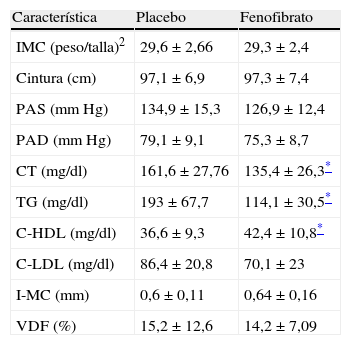El síndrome metabólico (SM) por su elevada frecuencia y porque aumenta el riesgo de desarrollar diabetes y eventos cardiovasculares se ha convertido en un problema de salud pública en México. Uno de sus componentes es la dislipidemia aterogénica la cual está constituida por hipoalfalipoproteinemia, hipertrigliceridemia y C-LDL en niveles variables incluso normales, sin embargo las guías internacionales señalan al C-LDL como el objetivo primario del tratamiento, lo que ocasiona que en la práctica clínica con frecuencia se omita corregir los niveles de TG y C-HDL lo que mantiene un riesgo residual en estos pacientes. No existe una recomendación oficial sobre el tratamiento de enfermos con SM, hipertrigliceridemia, hipoalfalipoproteinemia y C-LDL en meta ni estudios que exploren las condiciones vasculares de estos pacientes ni la respuesta al tratamiento con un fibrato.
ObjetivoDeterminar el efecto del fenofibrato sobre el perfil de lípidos y el estado vascular de pacientes con SM y la dislipidemia descrita.
MétodoSe incluyeron 12 pacientes en un estudio prospectivo, longitudinal, cruzado, doble ciego, controlado con placebo a base de 160mg diarios de fenofibrato durante 8 semanas. Se evaluaron perfil de lípidos séricos, función endotelial mediante vasodilatación dependiente de flujo y espesor de la íntima-media carotídea de control y al finalizar el tratamiento.
ResultadosEl fenofibrato redujo significativamente los niveles de TG, incrementó los valores de C-HDL y mejoró la función endotelial en la mayor parte de los pacientes, esto se asoció significativamente con el descenso en los valores de TG.
ConclusionesEste es el primer estudio que reporta estos cambios en este tipo de pacientes lo que sugiere que el fenofibrato puede ser una herramienta terapéutica que corrija la dislipidemia aterogénica y reduzca el riesgo cardiovascular en esta clase de enfermos.
The metabolic syndrome (MS), due to its elevated frequency and because it increases the risk of developing diabetes and having cardiovascular events, has become a public health problem in Mexico. One of its components is atherogenic dyslipidemia, which is made up of hypoalphalipoproteinemia-hypertriglyceridemia and C-LDL on variable, and even normal, levels. However, the international guides indicate C-LDL as the primary objective of the treatment, which means that the goal of correcting TG and C-HDL is frequently omitted in the clinical practice, this maintaining a residual risk in these patients. There is no official recommendation on the treatment of patients with hypertriglyceridemia-hypoalphalipoproteinemia or MS syndrome and C-LDL in the objective or studies on their vascular condition and response to treatment with a fibrate.
ObjectiveTo determine the effect of fenofibrate on the lipid profile and the vascular status of patients with described MS and dyslipidemia.
MethodA total of 12 patients were included in a prospective, longitudinal, crossed, double blind, placebo controlled study based on fenofibrate 160mg daily for 8 weeks. The serum lipid profile, endothelium-dependent flow-mediated vasodilatation function and carotid intima-media thickness as control and at the end of the treatment were evaluated.
ResultsFenofibrate reduced significantly the TG levels, increased the C-HDL levels and improved the endothelial function in most of the patients. This was significantly associated to a decrease in the TG levels.
ConclusionsThis is the first study to report these changes in this type of patient. This suggests that fenofibrate may be a therapeutic tool that corrects atherogenic dyslipidemia and reduces cardiovascular risk in this type of patient.
Artículo
Comprando el artículo el PDF del mismo podrá ser descargado
Precio 19,34 €
Comprar ahora












